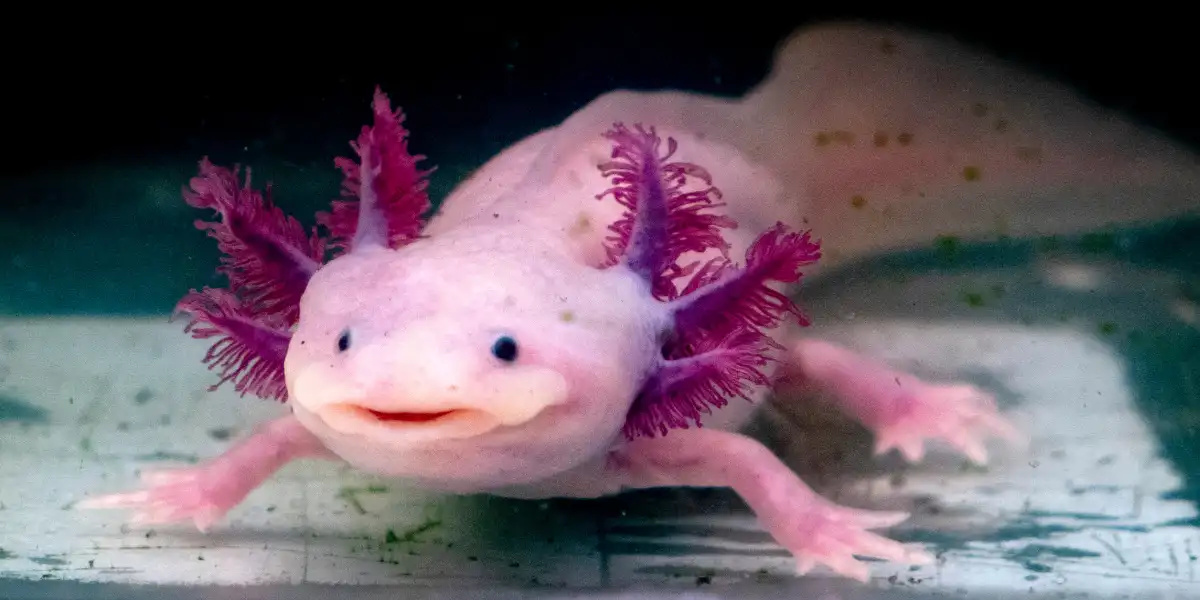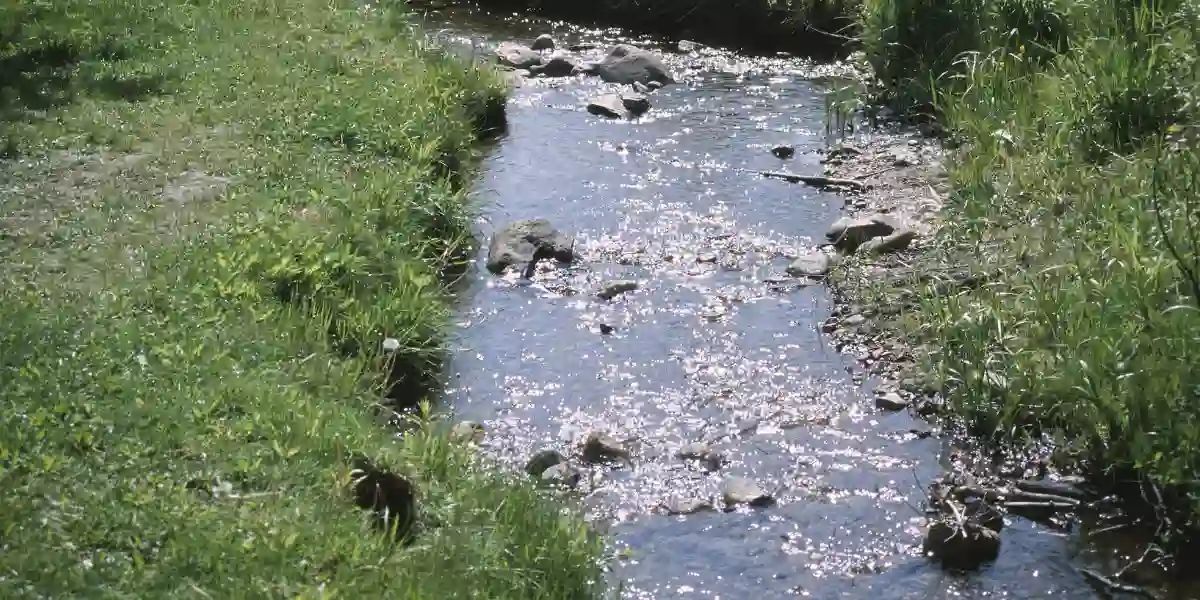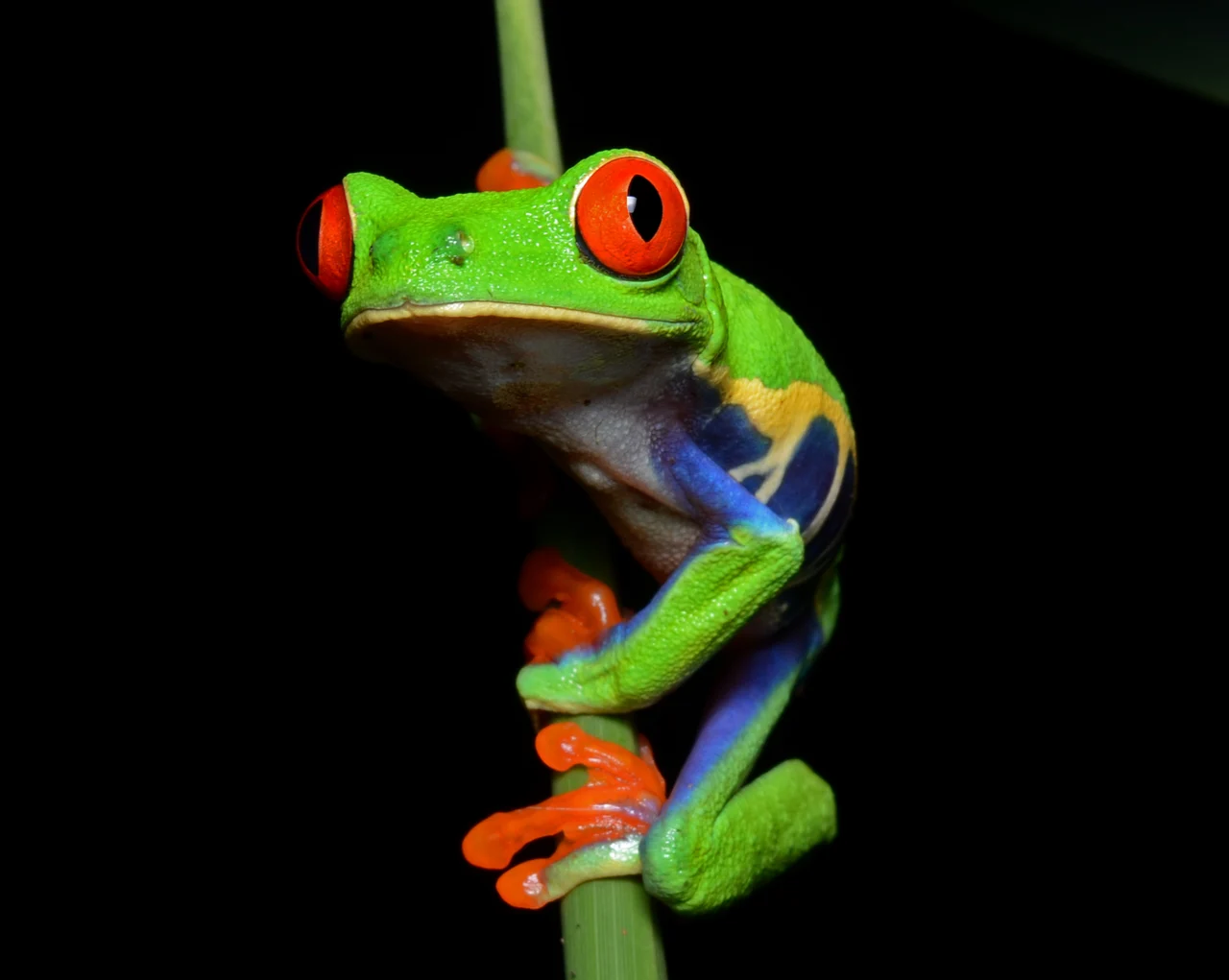An amphibian is a cold-blooded vertebrate animal that typically starts its life in water as an aquatic larva, then undergoes metamorphosis into a terrestrial adult. They have moist skin, lay eggs, and usually possess the ability to breathe through both lungs and gills. Examples include frogs, toads, salamanders, and newts.

Discover the fascinating world of amphibians, a diverse group of creatures bridging the gap between water and land. With over 7,000 species globally, these remarkable beings captivate with their moist skin and webbed feet, enabling them to breathe through their skin underwater.
Witness their extraordinary life cycle, from aquatic eggs to lung-breathing adults, and learn how some amphibians undergo multiple transformations. Uncover the ancient origins of these pioneers, who paved the way for the ecosystems we know today, acting as both hunters and hunted.
Dive into the captivating realm of amphibians and unlock the secrets of their amphibious adventures.
The Importance of Amphibians in the Ecosystem
Amphibians, known as “indicator species,” are vital components of ecosystems, reflecting their overall health. Their absence disrupts the balance, while their presence ensures stability.
Acting as both predator and prey, they regulate populations and control herbivorous insects, maintaining equilibrium and preventing dominance of one species over another.
As amphibians live both on land and in water, they consume a variety of organisms from each environment. When they die and decompose, these nutrients are then recycled back into the ecosystem through other organisms that feed upon them.

Their permeable skin makes them bioindicators, absorbing pollutants and signaling environmental changes caused by climate, habitat destruction, or pollution.
Amphibians play an essential role in safeguarding resources and human well-being. By monitoring their populations, we can detect early signs of environmental degradation, ensuring the availability of clean water, fresh air, and other vital resources.
A Brief History of Amphibians
Amphibians, among the oldest animal groups dating back over 300 million years, emerged from fish ancestors and ventured onto land approximately 375 million years ago. These remarkable creatures adapted to both aquatic and terrestrial habitats, swimming and breathing underwater while basking in the sun and laying eggs on land.
However, reptiles gradually outcompeted amphibians for resources as they evolved and adapted to terrestrial life. By the end of the Permian period, around 250 million years ago, climate change and reptile competition caused the extinction of many amphibian species. Presently, only around 7,000 species of amphibians remain on Earth, facing a decline in numbers.

Despite their diminished population, amphibians retain their crucial role in global ecosystems. They serve as sensitive indicators of environmental health, responding to changes in water quality and habitat degradation. The presence of healthy amphibian populations ensures the stability of entire food webs and prevents imbalances in ecosystems that can have significant consequences for humans and other wildlife alike.
What Are The Characteristics of Amphibians
Adaptability
Amphibians exhibit exceptional adaptability, thriving in both aquatic and terrestrial environments. This versatility enables them to inhabit various habitats, ranging from rainforests to deserts, showcasing their remarkable ability to withstand diverse conditions.
Permeable Skin
Amphibians possess thin, permeable skin, setting them apart from other vertebrates. This specialized skin allows them to absorb moisture and oxygen directly from the environment. Furthermore, it serves as a defense mechanism, containing toxins or irritants that deter potential predators.
Metamorphosis
A significant aspect of amphibian life cycles is metamorphosis. Starting as aquatic larvae with gills, they undergo a remarkable transformation into adults equipped with lungs or other specialized respiratory structures, including their moist skin. This process plays a pivotal role in their development and survival, enabling adaptation to diverse ecological niches as they mature.
Conservation Significance
The unique characteristics of amphibians make them captivating subjects for study and deserving of conservation efforts. By understanding their traits, we gain insights into broader scientific fields such as evolution, ecology, and environmental health. Additionally, recognizing their importance fosters conservation initiatives to protect these fascinating creatures and maintain the balance of ecosystems.
What Are The Types of Amphibians
Frogs: Jumpers and Swimmers

Frogs, the most recognized amphibians, possess long hind legs for jumping and webbed feet for swimming. They have smooth, moist skin capable of absorbing oxygen from both air and lungs. Frogs vary in size, ranging from tiny tree frogs to large bullfrogs measuring up to 8 inches long.
Toads: Specialized Frogs

Toads belong to the frog family but have distinct characteristics. They typically have dry, bumpy skin that acts as a defense mechanism, discouraging predators. Toads have shorter hind legs compared to frogs, making them better suited for walking than jumping. They are known for their terrestrial lifestyles, often found in drier habitats.
Salamanders: Walkers with Tails

Salamanders, another common amphibian type, feature four legs primarily used for walking. Unlike frogs, they rely less on jumping and swimming. Salamanders sport a tail that aids in balance and serves as a defense against predators. Their skin is usually moist, with diverse colors and patterns.
Newts: Aquatic Salamanders

Newts are a subcategory of salamanders known for their aquatic lifestyle. They have four legs and a tail, using all appendages for swimming. Newts display a wide range of colors and patterns on their moist skin, adapting to various aquatic habitats.
Mudpuppies: Aquatic Salamanders with Gills

Mudpuppies, another subcategory of salamanders, are fully aquatic with four legs and a tail. They possess external gills throughout their lives, allowing them to breathe underwater. Mudpuppies have moist skin, often with dark coloration, aiding in camouflage in their aquatic environments.
Caecilians: Burrowers and Aquatic Inhabitants

Caecilians, the lesser-known amphibians, spend the majority of their time underground or in water. Resembling worms or snakes, they possess small eyes and sharp teeth for capturing prey. Caecilians lack legs but have embedded scales in their skin, facilitating movement.
Amphibian Habitats and Distribution
Diverse Habitats for Amphibians
Amphibians and their corresponding regions by continent:
| Continent | Species Name | Region |
|---|---|---|
| Africa | African Clawed Frog | Sub-Saharan Africa |
| African Bullfrog | Sub-Saharan Africa | |
| Painted Reed Frog | Sub-Saharan Africa | |
| Goliath Frog | Equatorial Guinea, Cameroon | |
| Asia | Asian Common Toad | Southeast Asia |
| Japanese Giant Salamander | Japan | |
| Chinese Giant Salamander | China | |
| Indian Purple Frog | Western Ghats, India | |
| Europe | Common Frog | Europe, Western Asia |
| Fire Salamander | Europe | |
| Alpine Newt | Europe | |
| European Tree Frog | Europe | |
| North America | American Bullfrog | North America |
| Red-eyed Tree Frog | Central America | |
| Eastern Newt | Eastern North America | |
| Hellbender | Eastern United States | |
| South America | Poison Dart Frog | Central and South America |
| Surinam Toad | South America | |
| Glass Frog | Central and South America | |
| Axolotl | Mexico | |
| Oceania | Green Tree Frog | Australia |
| Cane Toad | Australia, Pacific Islands | |
| Papua New Guinea Harlequin Frog | Papua New Guinea | |
| Archey’s Frog | New Zealand |
Amphibians exhibit remarkable adaptability, thriving in a wide range of habitats worldwide. They can be found in various environments, including tropical rainforests, arid deserts, wetlands, ponds, rivers, streams, and even underground caves.
Wetlands: Vital Breeding Grounds

Wetlands play a crucial role as habitats for many amphibian species. These areas, characterized by high moisture levels and abundant vegetation, serve as important breeding grounds. Amphibians such as frogs and salamanders rely on wetlands for breeding and may spend their entire lives in these water-rich environments.
Ponds and Small Bodies of Water: Safe Spaces for Breeding

Ponds and other small bodies of water are significant habitats for amphibians. They provide safe spaces for breeding and egg-laying. Many species deposit their eggs on leaves or sticks near the water’s edge, allowing them to hatch and develop into tadpoles before transitioning to land as adults.
Rivers and Streams: Lifelines for Survival

Rivers and streams are common habitats for amphibians, offering a continuous flow of water vital to their survival. Along riverbanks, species like newts and salamanders seek shelter under rocks or logs, utilizing the water’s resources and habitats.
Amphibians inhabit a wide array of habitats, from wetlands and ponds to rivers and streams. These diverse environments are essential for their breeding, development, and survival. However, human activities pose significant threats, making conservation efforts and habitat restoration imperative to preserve these incredible creatures.
Popular pet species of amphibians and their corresponding regions by continent:
| Continent | Species Name | Region |
|---|---|---|
| Africa | African Clawed Frog | Sub-Saharan Africa |
| Asia | Oriental Fire-Bellied Toad | Eastern and Southeast Asia |
| Axolotl | Mexico | |
| Europe | Common Fire-Bellied Toad | Europe, Western Asia |
| North America | American Bullfrog | North America |
| Red-Eyed Tree Frog | Central America | |
| White’s Tree Frog | Australia, New Guinea | |
| South America | Argentine Horned Frog | Argentina, Uruguay |
| Pacman Frog | South America | |
| Brazilian Rainbow Boa | Brazil | |
| Oceania | Green Tree Frog | Australia |
| White-lipped Tree Frog | Australia | |
| Asian Painted Frog | Southeast Asia |
***It’s important to note that regulations and availability of certain species may vary depending on local laws and conservation considerations. Always research and adhere to legal requirements when considering keeping any amphibian species as a pet.***
What Are Conservation Efforts for Amphibians
Protecting Crucial Habitats
Preserving amphibian habitats, including freshwater streams, ponds, wetlands, and forests, is vital for their conservation. Human activities like deforestation, agriculture, and urbanization have led to habitat loss. Legislation and education can help safeguard these habitats, providing a safe environment for amphibians to thrive.
Captive Breeding Programs
Captive breeding programs involve taking individuals from wild populations and breeding them in controlled environments such as zoos. Offspring from these programs can be reintroduced into the wild to support population recovery or habitat restoration efforts.
Public Education for Awareness
Raising awareness about the importance of amphibians in ecosystems and the impact of human actions is crucial. Many people lack knowledge about amphibians’ significance and their vulnerability. Educating the public can foster understanding and support for the conservation of frogs, salamanders, and other amphibians.
A Comprehensive Approach
Conserving amphibians requires a multifaceted approach. Protecting habitats, implementing captive breeding programs, and educating the public about their ecological importance are all essential components. By combining efforts on these fronts, we can work towards securing the survival of these fascinating creatures for future generations.
Frequently Asked Questions
An amphibian is a type of animal that is characterized by its ability to live both in water and on land. These creatures, which include frogs, toads, and salamanders, undergo a unique life cycle known as metamorphosis, where they transition from an aquatic larval form to a terrestrial adult form. Amphibians typically have moist skin, lay their eggs in water, and possess adaptations such as webbed feet or strong legs for swimming or walking. Their ability to thrive in both aquatic and terrestrial environments makes them distinct from other types of animals.
Amphibians are neither fish nor reptiles. They are a distinct group of animals with their own classification. While they share some characteristics with both fish and reptiles, amphibians have unique features that set them apart. Unlike fish, amphibians have lungs or specialized respiratory structures and can breathe air. Unlike reptiles, amphibians typically have moist skin and undergo metamorphosis during their life cycle. Amphibians include animals like frogs, toads, and salamanders.
Yes, amphibians do lay eggs. In fact, egg-laying is a common characteristic among most amphibian species. Amphibians typically lay their eggs in water or in moist environments near water sources. The eggs are usually surrounded by a protective jelly-like substance that helps keep them hydrated. After the eggs are laid, they undergo development, usually hatching into aquatic larvae, such as tadpoles, which have gills for breathing underwater. As the larvae grow and develop, they undergo metamorphosis and eventually transform into the adult form, equipped with lungs or other specialized respiratory structures for breathing air. This unique life cycle, including the egg-laying stage, is a defining characteristic of amphibians.
A turtle is classified as a reptile rather than an amphibian due to several distinct characteristics. Reptiles, including turtles, are a group of animals that have evolved specific adaptations for life on land. Unlike amphibians, turtles are not dependent on water for their entire life cycle. They have a hard, protective shell that covers their body, which is a unique feature among reptiles. Turtles also have scaly skin, like other reptiles, which helps prevent water loss and protects them from the environment. Additionally, turtles lay eggs on land, whereas amphibians typically lay their eggs in water. These distinguishing features and adaptations place turtles firmly within the reptile group rather than as amphibians.
Amphibians and reptiles are two distinct groups of animals, each with their own characteristics. Amphibians are a class of vertebrates that typically have moist skin, undergo metamorphosis during their life cycle, and can live both in water and on land. Frogs, toads, and salamanders are examples of amphibians. On the other hand, reptiles are also a class of vertebrates, but they have dry, scaly skin, breathe air with lungs, and are exclusively terrestrial or semiaquatic. Reptiles include animals such as turtles, snakes, lizards, and crocodiles. While both groups share similarities, such as being ectothermic (cold-blooded), their differences in skin, life cycle, and habitat adaptations distinguish them as separate classifications within the animal kingdom.
Conclusion
Amphibians are a fascinating group of animals that play important roles in the ecosystem. They have a long history on Earth and have adapted to various habitats across the world, from deserts to rainforests.
Unfortunately, many species of amphibians are facing threats such as habitat loss and disease. However, there are conservation efforts underway to protect these animals and their habitats.
Through conservation efforts and education, we can work towards a future where these fascinating creatures continue to thrive in their natural habitats. By taking action now, we can ensure that future generations will be able to appreciate these unique animals for years to come.




